To me, and probably lots of other people my age and younger, the Dungeons & Dragons 3rd Edition Monster Manual is clearly the one and only true monster book. It was the one I started with and unlike the later monster books for the edition, it had all the normal monsters, like orcs, goblins, ogres, owlbears, manticores, yuan-ti, beholders, gelatinous cubes and so on. Well “normal” for Dungeons & Dragons. But it also had quite a number of creatures that always made me think “did anyone ever use this?” and that never seemed to make any appearances in any other books. There was just that one entry with the weird picture, which I soon didn’t even notice any longer when I flipped through the book looking for monsters for my adventures. Since I assume that lots of people felt similar about them, I wanted to give this one the Fantasy Safari treatment for quite some time, even though it’s possibly the least obscure monster book for almost anyone under 30.
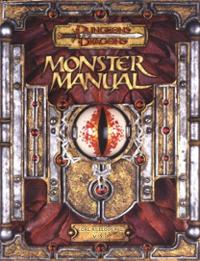
Monster Manual for Dungeons & Dragons 3rd Edition by Wizards of the Coast, 2000/2003; 266 pages of monsters.
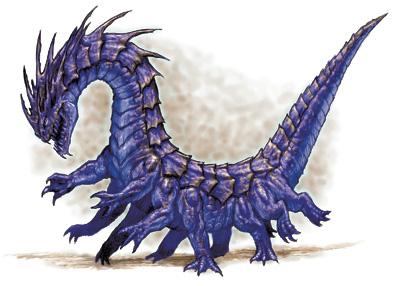
I am not going to lie, I love the Behir mostly because of the picture. Damn, this thing looks cool. A behir is a huge spiky purple snake with lots of small legs. While they are not particularly bright, they are still of somewhat human-like intelligence and able to talk. But like animals they are of neutral alignment, which means they shouldn’t be attacking everyone they encounter on sight, as an intelligent creature killing other intelligent creatures for food is almost always considered evil, no matter what particular interpretation of alignment you follow. Though that leaves the question, how do they interact with player characters? They probably would defend their home against intruders and keep anyone from stealing their treasures, but with a creature like this its hard to imagine why they would even have treasure in the first place. The most likely situation I can imagine for players to fight a behir would be the behir being in service to some other more powerful creature or NPC and guarding the entrances to their stronghold. But even then, given the behirs usual alignment and intelligence, talking might be a real option as well. As a giant worm, a behir has all the common abilities of such creatures in 3rd edition, as wrapping around a smaller creature and crushing it or swallowing it down in one go. It also has a lightning breath, but as it can be used only once per minute, it probably will use it only once in a fight. The behir is actually a pretty old creature that predates the Monster Manual by almost 20 years, but I’ve never really seen it used anywhere through all editions.
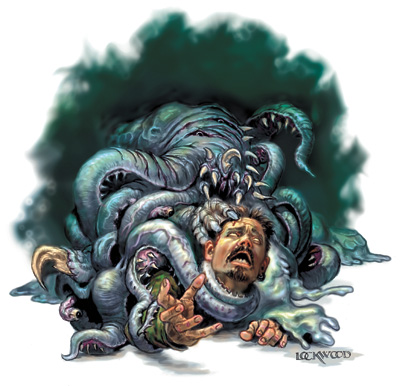
Chaos Beast, we meet again. It’s the Foaming Blasphemy from the Bestiary of the Hyborian Age. The Monster Manual actually predates the Bestiary by several years, but since the Bestiary usually only includes creatures from Conan stories, I think it’s a strong indication that this is where D&D got the idea from. The Bestiary then just copied the rules for the mechanical implementation that had already been written up for D&D. (Since the Conan d20 RPG is basically the same system; why invent the wheel twice?)
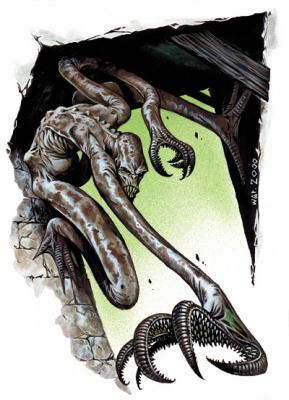
The Choker is a small creature of almost humanoid appearance, but its arms and legs are actually flexible tentacles. For creatures of their size and weight, chokers are amazingly strong and can climb like nobodies business. They are also very fast and can dart around and make multiple attacks at the same time, which in the way the game works could be very dangerous particularly at lower levels when player characters don’t have much flexibility in tactical combat. Chokers often try to hide above doorways and under the ceiling and are very well hidden for low-level monsters. Unsurprisingly, they use their tentacle arms and legs to grab victims and strangle them, but since they are meant for low level parties they actually deal only very little damage. I believe they are a new creature introduced in 3rd edition.
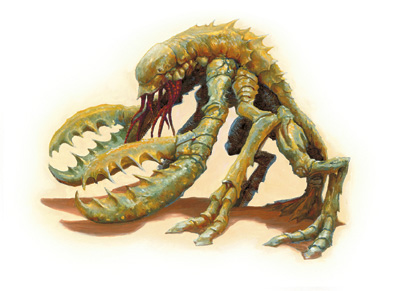
The Chuul is a creature that used to confuse me, but which I now actually really love quite a lot. It’s a completely new monster created for this book. A chuul is basically a very large intelligent lobster, though the description says it also has elements of insects and snakes, which are not really apparent in the picture. Its main attacks are its two huge claws which are nothing to laugh at, but it also can use them to grab an enemy it hits and keep a hold on it. In following rounds, it just needs to squeeze to deal more damage without having to make a new attack roll. 3rd edition loved it’s Improved Grab and Constrict abilities and there are dozens of monsters who have this. And it’s a cool idea in principle, but an extension of the horribly written grapple rules that are probably the most hated thing in the d20 system ever. In over a decade of running campaigns with this game, I think I never used this ability once, simply because I never really could get my head around it. Which sucks, because having a party member being held up in the air, flailing around, and trying to stab the monsters with a dagger while the others are trying to help him would be really cool. In addition to its claws, the chuul also has paralyzing tentacles at its mouth. It can’t attack with these normally, but use them against an enemy it grabed with a claw to take it out of the fight and go back to fighting the rest. Chuuls are a classic swamp monster, but they are also as intelligent as humans, which is a nice twist that might not be apparent at all during the first encounters. I also love the illustration, especially how you can’t really tell for sure where its face is. There are at least four possible positions for its eyes. When I went to make the Underworld monsters for my own Sword & Sorcery setting, I tried to make monsters that are based on insects and worms and also have no regular face. So of course there’s also one type among them which is heavily based on this picture. (Though not much else from this monster.)
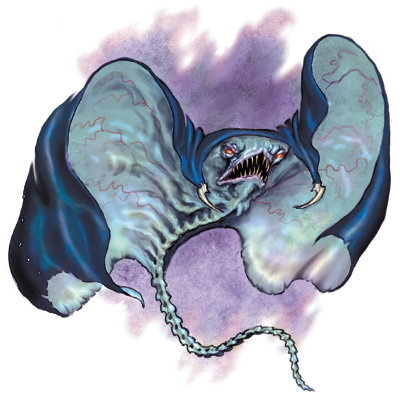
The Cloaker is an old monster, which I think goes back even to AD&D 1st edition. It started as one of those stupid “everything is trying to kill you” monsters and uses its two hooks near the head to grab on to a wall, which makes it look like a cloak hanging from a rack. Which will then jump you and try to kill you when you get too close. I think I might make a whole article about this particular class of early D&D monsters later on. There is a lot more of them and cloakers are really among the least stupid of these. The cloaker has fascinated me right from the begining, simply because of this really cool picture. I really love almost all of the Todd Lockwood and Sam Wood illustration from the very first 3rd edition books and I have no idea why they stopped getting hired later on. Wayne Reynolds is also cool, but using him so much made D&D look like Warcraft. Which is also a cool fantasy setting, but really not at all what Dungeons & Dragons should be like. But back to the cloaker: Cloakers are subterranean creatures reselmbling aquatic rays that have the ability to fly. They are highly intelligent, like many underdark monsters, but despite their fearsome appearance not actually evil. Which, like with the behir, raises the question how players would be expected to interact with them. Being intelligent, able to talk, and not generally cruel or hostile to other intelligent creatures, how would they react to PCs? Unfortunately, this monster manual never goes into this at all. It’s a book of combat stats, which sadly is very indicative to the whole approach WotC has to Dungeons & Dragons. Murderhobos: The Game. The abilities of the cloaker are quite interesting and unusual, though. They can groan in barely perceptible voices that still have various strange effects on the brains of other creatures, causing either great anxiety, total panic, nausea, or paralysis. Which I think is a really neat new approach to monster abilities. Some time ago it had been discovered that the human brain does indeed start to “glitch” when exposed to certain low-frequency vibrations. There is one particular frequency which very reliably makes people see ghost. And happens to sometimes be produced by aging ventilation fans. Instant haunting by the flick of a switch. Cloaker voices seems to work like that. Cloakers also have some strange relationship with shadows, which they can use to produce certain illusions. Running into cloakers that have not yet revealed themselves could be a really spooky encounter. And even when they do show themselves, you’re face to face with that nightmare shown above!
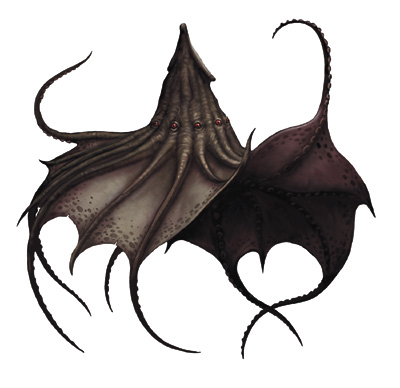
The Darkmantle reminds me of a couple of different monsters from AD&D, but I think this version did not appear before 3rd edition. It’s like a small kind of squid that lives underground and can fly. Of course it can. It uses the sucker on the base of its body to cling to the ceiling and then let is arms hang down to create the appearance of a stalagtite. It actually behaves very similar to chokers, waiting for a target to come nearby and then drop on it from above trying to strangle it. It of course also falls into the “everything is trying to kill you” category of monsters like the cloaker.
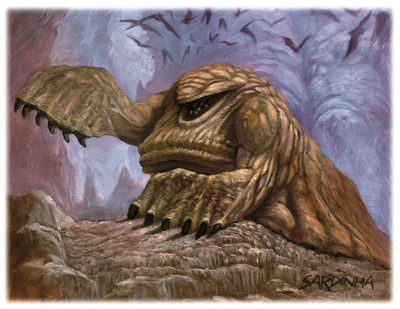
The Delver is another one of the really strange monsters from 3rd edition. To my knowledge it doesn’t have any tradition in D&D and was created specifically for this book. It’s a huge subterranean creature that digs itself through the ground, wanting nothing more but eat various kinds of minerals, while happening to have a pretty high intelligence above most humans. I always ignored it, having looked at it once and thought it was stupid. However, whoever wrote this thing did appear to have some idea what it would be for. Delvers are usually reclusive and don’t really want contact with anyone, but they really love to eat metal and can get quite crazy for it. Which of course sucks when you are mining valuable ore and a delver finds your mine. Sometimes they even attack people to eat their weapons and armor. They are not evil and very intelligent, but just have this huge craving for metal. So that’s clearly one interesting hook how to include them in a game. But unfortunately, it also seems to be the only thing you really can do with them. “We got this big fella in our mine who is eating all our iron. Please make him leave!” Once you did that adventure one time, the potential uses of the delver seem to be exhausted. The only other use I could think of would be to have dwarves or deep gnomes bribe a delver with metal to use as a siege engine to attack an enemy stronghold. Since its not evil, it could also be working for duergar or drow, but be very willing to switch sides if approached by the PCs. This is actually not a stupid or useless monster, but the book doesn’t really make a good job at explaining it. Given its abilities, this creature is much more interesting as something you should not fight. Sadly, this was not the path that D&D would take after 3rd edition was released, so I believe the delver never really saw any use.
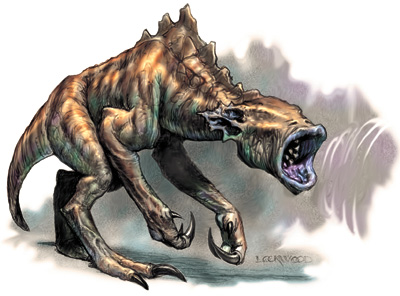
The Destrachan is another underground creature, because that’s where all the really weird critters live. It’s a big bipedial lizard somewhat similar in stature to a small hadrosaurus, but also predatory and completely blind. Being at home miles underground in the dark, destrachans don’t even have any eyes and percieve their environment entirely by sound like bats. Of couse they are also intelligent creatures, but these ones are actually plain evil. Yes! Finally some bastards who really need killing. Like the cloaker, a destrachan can use its voice not just for echolocation, but also as a weapon. The pressure waves from a destrachans throat can cause significant damage to muscles or organs, or alternatively paralyze nerves. As a third option, a destrachan can even shatter wood, metal, or stone that way. Naturally its very dificult to damage a destrachans hearing to make it unable to locate other creatures. And again, this Lookwood illustration looks really great. Actually, since this post has already turned into an unashamed soapbox a long time ago, lets talk some more about monster manual art. Leonaru at RPG.net is currently doing his own series on the 5th edition Monster Manual which also discusses the art. While the art in that book is pretty well done and serviceable and also looks pretty high quality at first, it really leaves a lot of people cold. Part of that is because of the boring poses in which the creatures are show, but what makes them particularly boring looking to me is the lack of colors and textures. Those creatures are usually uniformly brown or uniformly gray. This really cool looking Lockwood illustration, like the cloaker above, have a lot of texture and colors, and they just look amazing! It also helps that the two creatures are not just standing there, but seem to be in the middle of an attack, which makes them more dynamic and gives you an impression how it would be when the PCs are fighting with them. There isn’t really much to see, but its so much more interesting than something that looks like a biology textbook illustration.
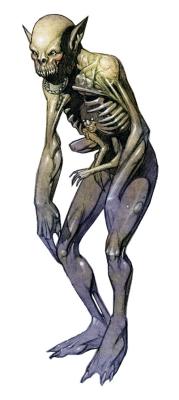
The Devourer is another older creature, which I believe is actually from Planescape. It’s an undead monster from another dimension and while mostly human shaped, its actually pretty huge, standing almost 3 meters tall. These things are really very dangerous and highly intelligent and have a number of spells like confusion, suggestion, ray of enfeeblement, and true seeing. Like any self-respecting high level undead, devourers can drain the life force of living creatures, but can do so even at a distance. The most distinguishing ability of devourers is to rip out another creatures soul and trap it inside its own ribcage. This soul serves as fuel for the devourers spells and will eventually become consumed. This is a seriously creepy creature. But like many monsters in this book, it suffers from lacking any explanation about what it wants and how it behaves. A high level monster with high intelligence and the ability to cast suggestion is not something that just jumps around the corner trying to eat you. So what does it do? This book doesn’t tell.
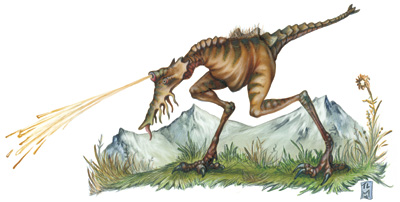
The Digester is a strong contender for the dumbest monster in this book, but much of that might be because of the illustration. It’s basically a deinonychus with a stupid looking head that spirts acid. I think I once saw these things mentioned in an adventure from Dungeon, but I’m not even sure about that. Lack of meaningful description of any kind makes this creature just meh.
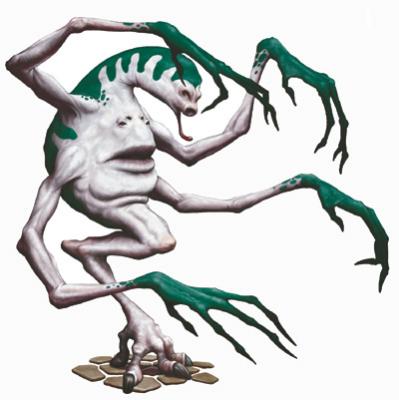
I think the Ethereal Filcher is hands down the weirdest thing to ever appear in any D&D book. This beats brain collectors and pherims by a long shot. As their name indicates, ethereal filchers are creatures from the ethereal plane, a place that is often mentioned in D&D but to my knowledge never really explored in any way. Mostly because it’s supposed to be almost entirely empty and featureless, I believe. The filcher is one attempt to add something to that plane, and I think we have to consider it a complete failure. They actually live in very hard to reach caves on the material plane, only moving through the ethereal plane to get in and out of their lairs and to sneak up on their prey. What they do is using their natural ability to sense magic to find people carrying magic items. Then they pop out from seemingly nowhere, grab the item, and return back to the etheral plane. Which really sounds like a terrible monster to use in your game. A group of 3rd level characters should have no ways to track or follow the ethereal filcher in any way and any item it gets a hold on is almost certainly gone forever. This just sucks. No wonder they were never used for anything to my knowledge.
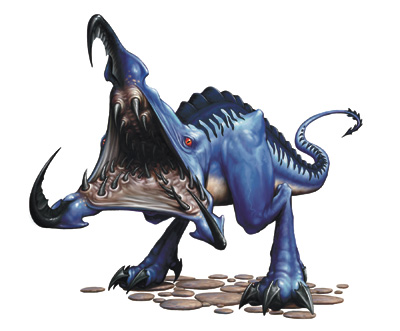
The Ethereal Marauder is another creature from the ethereal plane and actually native to that place. It also does not look nearly as insane as the ethereal filcher. It is also not much better as a monster, though, as it uses the same trick of popping out from nowhere, delivering a bite against their prey, and disappearing again until their target is dead. There isn’t really anything 3rd level characters could do about it other than readying an action, but as a GM, I would not allow players to say “I attack the thing when it pops up again in any of the six squares next to me”. At the very least you’d have to specific the space you are targeting and in that case the marauder just pops up behind your back.
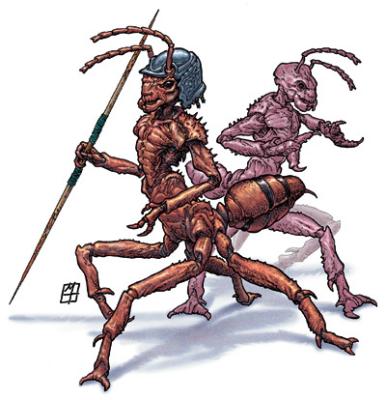
I believe Formians are a race that originates in Planescape, or at the very least had their greatest appearance in that setting. I think they have something to do with the border between the lawful outer planes of Mechanus and Arcadia, but nothing else is said about this in this book. They are still described as agressivelly expansionist, trying to create new colonies everywhere and taking control of every place they come to. There are several different types of formians, ranging from the small and quite weak workers to the very powerful myrmarchs and of course the magnificent queens. All formians within a 50 mile radius of the queen are always in telepathic contact with each other, making it almost impossible to surprise them or infiltrate their lairs. If one of them sees you, all of them know you are there instantly. Formians have various magical abilities depending on their rank. While workers are pretty weak and harmless, groups of them can work together to cast the spells cure serious wounds and make whole unlimited times per day, so any damage adventurers may cause to a colony will be very quickly repaired. Unless a formian is outright slain in battle, it will be back at full strength a few minutes later as long as workers can get to them. Taskmasters not only control formian workers and warriors, they also have the ability to telepathically control almost any kind of living creature and will almost always be accompanied by bodyguards of some other race. Myrmarchs have even more powers than that and the queen of a hive is always a sorcerer of at least 17th level. Even though workers and warriors are not very strong or dangerous by themselves, it is very unlikely that players will just run into a small group of them. Formians will almost always be encountered as a complete hive that at the very least consists of several dozens of warriors and hundreds of workers. And given their extremely effective organization they are also significantly more dangerous than just their individual numbers. If you’re using formians as opponents for your campaign and you are using them as described, it almost certainly should be as a major threat and the centerpiece of the whole adventure, most likely for pretty high level characters of 15th level or above.
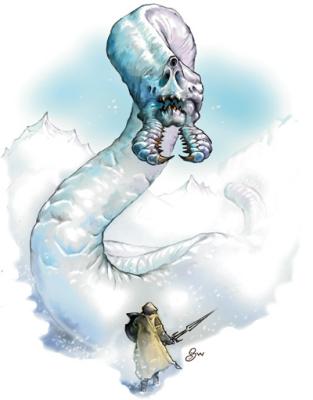
The Frost Worm is another Conan creature. But a pretty cool and also very bad one. It’s some huge kind of white worm native to arctic environments, but I believe it also has been used in high mountains in the Forgotten Realms. As expected, their bite deals extra cold damage and they have a freezing breath that deals a staggering amount of damage. They also can make a whistling sound that numbs the mind of any creatures within 30 meters, making them effectively stunned. When killed, a frost worm instantly turns into ice and explodes, dealing 20d6 points of damage to everything within 30 meters. The idea is fun, but why 20d6? This is a CR 12 monster and one I would most likely use against 10th or 9th level PCs as a kind of boss monster. And it uses the ability at the very end of the fight, when it most likely already did considerable damage to the characters. 20 to 120 damage against injured 10th level characters is not fun. That’s 70 damage on average, no 10th level wizard or rogue is going to have that many when at full health. Most likely several characters will be killed after they have already won the fight. Sure, you can defend against it because most of it is cold damage. But that requires knowing in advance that you are going to fight a frost worm and that it has this ability. Which is not how this game is supposed to work.
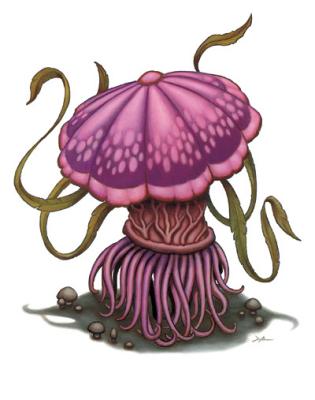
The Fungus entry is one I practically just skipped over from the very beginning. The shrieker and violet fungus are not really monsters but more like traps. A shrieker is a large subterranean purple fungus that really can’t do anything and has no Strength, Dexterity, or Intelligence score and Wisdom and Charisma scores of 2 and 1. They don’t have any attacks either and all they do is to make a loud noise when anything comes within a few meters of them, which of course will allert ant creatures in the surrounding area. A violet fungus poses are more direct threat, having long tentacles coated in a strength sapping poison. They can even slowly move around, though I don’t see how that will do them any good in a fight. I think both these types of fungus work best, or just work at all, in dungeons that are set up as dynamic environments. The only purpose of shriekers is to allert other creatures and make them come and investigate and a violet fungus is much more likely to severely cripple characters instead if killing them. If you go from room to room to kill the creatures that are waiting there for you, and there is really only one path to take through the dungeon, they are indeed entirely pointless. Which is probably why I never used them or saw them in any published adventures. They are most interesting when players set them off by accident, destroying all their careful plans to sneak into a place unnoticed, or when you know what they are and have to take them out in a stealthy way. Which both is pointless when you will kill every living thing in a straight up fight anyway.
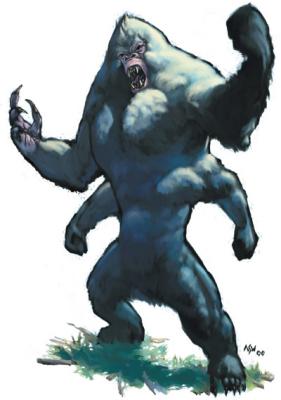
The Girallon is new in D&D but actually almost century old. It’s the great white ape from the novel A Princess of Mars. In most pictures I’ve seen of the great white apes they are shown to be pretty huge, while the girallon isn’t particularly big. It’s a gorilla with white hair and four arms, and that is really everything D&D did with it. Pretty disappointing and I don’t think it was used much. (Evil Ape +1)

The Gray Render is really a quite interesting creature. It’s a big beast of very simple intelligence with no real special powers, but with the natural instinct to become close friends with other smaller creatures. It most commonly has neutral alignment but will defend its small friends at absolutely any cost. I think it can be a really interesting addition to a group of kobolds, halflings, or druids, and with a CR of 8 it really is quite the nasty beast. I only saw a gray render outside the monster manual once, which was in an adventure for 15th level characters. Even advanced to more hit dice it really didn’t make any difference to the encounter it was part of. For some weird reason the book also tells us that gray renders don’t mate but simply produce an infant clone of themselves once in a while. This is an interesting idea once, but I think there is well over a dozen creatures in this book that reproduce this way, which really doesn’t make sense for complex creatures. While there are some species of small lizards that have such a way of reproduction, it’s an evolutionary dead end and can only work in small isolated areas for as long as the environment does not change. It just doesn’t make any sense in a large number of highly complex species, especially when most of them are supposedly ancient and highly advanced.
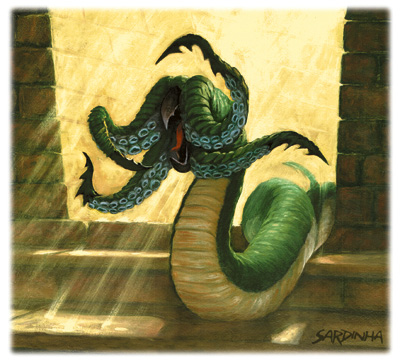
The Grick is a creature I always considered boring, and taking another closer look at it now and examining it for potential uses as an interesting encounter, I have to confirm: Yes, it really is boring. It is CR 3, has only 2 hit dice, an Intelligence score of 3, and is neutral. Damage from nonmagical weapons is reduced by 10, but with only 9 hit points that still doesn’t make them really a threat in the 3rd edition encounter system.They got these tentacles in their face, but even those just deal small ammounts of hit dice damage. (Because in the logic of D&D, four tentacles means four attacks per round and we can’t have them dealing too much damage.) The illustration doesn’t help them either, as even though they are aberrations the creature in the picture looks just like a big snakes with four smaller snakes instead of a head.
The Hell Hound is a dog from hell. It can breath fire and its bite deals fire damage, and it also is somewhat intelligent, though not very bright. (Demon Dog +1)
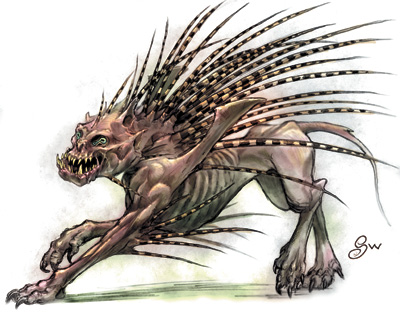
I have always liked the Howler, which again is entirely just because of the illustration. While the picture makes it look like some kind of demonic rat, a howler is actually larger than a horse and weighs about a ton, which I found really exciting when I actually noticed that some years later. They are pretty weak individually though, similar to hellhounds. Howlers are another Planescape monster, where they are native to Pandemonium, and endless system of caverns blasted by permanent winds. It is also notorious for making people quite mad and howlers a fitting right into that place. Anyone who hears the howlers howling in the distance must make a relatively easy saving throw or lose one point of Wisdom per hour. While not that interesting in a fight, I really do like their background and how they fit into the larger environment. But even though this particularly illustration doesn’t show it, they really are just another kind of demon dog. (Demon Dog +1)
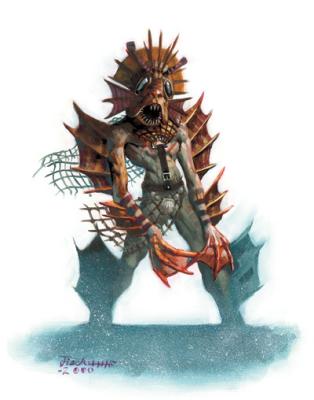
The Locatha is the most puzzling creature in the Monster Manual. Because it doesn’t have any even slightly interesting trai at all. It is an aquatic humanoid with 2 hit dice, completely average stats, and absolutely nothing else. And the picture looks stupid. I think I saw them mentioned once, with the Forgotten Realms Campaign Setting mentioning that they are distant descendants of one of the five first races that inhabited the planet a hundred thousand years ago. They never made any appearance, though. This is the lamest creature ever, making even wolves and dire rats exciting by comparison.
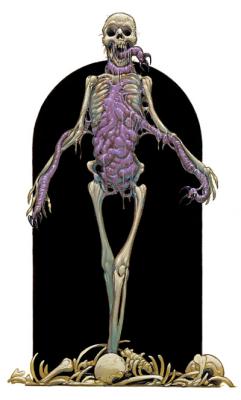
The Mohrg looks both icky and also pretty cool. It’s a human skeleton whose chest is filled with purple worms. It is however not a worm riding a human skeleton, but really a single undead creature that is created from a murderer who died unpunished. And it seems to be implied that it is the evil soul that makes the criminal return to unlife and not the work of a necromancer, which really raises the question where these worms are coming from? Perhaps the artist got unclear instructions what it should look like. A morg attacks both with its hands and its tongue, which in this illustration is also a worm. The tongue causes paralysis in living creatures, while it can also use the Improved Grab ability when it hits with its arms. Since humanoid ceatures never have the Improved Grab ability, I would guess the best way to describe it in combat would be to have the worms that are wrapped around the arm bones wrap around the target and hold it. The players sure would appreciate it. A mohrg is much more powerful than a skeleton and other than in appearance has nothing at all in common with those. When a creature is killed by a mohrg it raises as a simple zombie, but only after one to four days. Which in completely useless in combat, and you would have to add a lot of zombies to make a fight against a CR 8 monster more challenging. Considering all this, the writer who created the mohrg probably had much more in mind for it than just being a stronger skeleton to jump out from behind a corner and be killed in two to three rounds. This creature is really much better suited as the centerpiece of an entire adventure. One to four days is quite some time in which a lot can happen to a corpse. The mohrg might take it back to its lair and wait for it to rise, or it might be left where it fell. Or it might even have been found and already burried in the graveyard or being prepared for burrial. Suddenly, zombies! Zombies everywhere! A great investigation adventure which at the end will come together with a fight against the mohrg itself. Which being a murderer in life, should also have some backstory to go along with. This is exactly the kind of hidden information I am looking for in these books. Monsters that are much more than something to encounter standing in a dungeon room and to be forgotten four rounds later, but are actually made to have adventures created around them. And I must ask, why doesn’t this book spell this out?! This book is 15 years old, I had it since it first came out, and I have been using it countless times. And only now, carefully disecting each obscure monster and searching for tiny details that might be used as plot hooks, did I ever notice it? “1d4 days” is only seven characters, but they make all the difference. Why hide it? Would it have been so hard to add two more sentences to the description? Imagine if they had made that effort for all monsters in this book? D&D would be a completely different game than it is today and not the rules obsessed tactical combat simulation that it became.
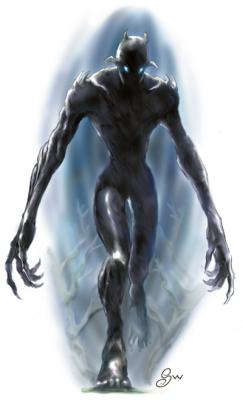
Do I have to say it again? I probably shouldn’t, but I’ll do anyway: This Nightshade illustration is fucking awesome! Like almost all Sam Wood illustrations in this book. The perspective makes it clear that this is a not a human sized guy and when you check the description it’s fucking huge. Not just big, but size category: Huge. A 6 meter tall bastard of pure darkness with blue glowing eyes. Nightshades come in three variants, the nightwing (huge bat), nightwalker (huge man), and nightcrawler (gargantuan worm) and are from the Known World setting of BECMI. Which I think is the reason for its biggest flaw. In BECMI, character levels go all the way up to 36, almost twice as high as the maximum of 20 in the 3rd edition core rules. Unfortunately, when converting the creature this difference was apparently not accounted for making the nightshades pretty high level creatures with a CR of 16 for the nightwalker. Which means I never got any opportunity to use it. Let me get my soap box, I think I need it today. I hate high level play in D&D. My campaigns usually don’t go any longer than 3 years and almost all of them start at low levels, because I very often get lots of people to play who never played any RPGs before. And since I don’t run dungeon crawling grind-fests, I’ve never seen any PCs of a level higher than 8th, either as GM or as player. And the way D&D is set up, that meant a huge amount of content never could be used at all. Like this cool badass bastard. Today I know better and could just rebuild him as a CR 8 creature and use that, but I used to be a young and stupid GM and that never really occured to me. I am afraid I don’t have much to say about the monster itself. There isn’t really any description what it is and what it does, and the abilities don’t seem interesting either. But damn, it looks cool.
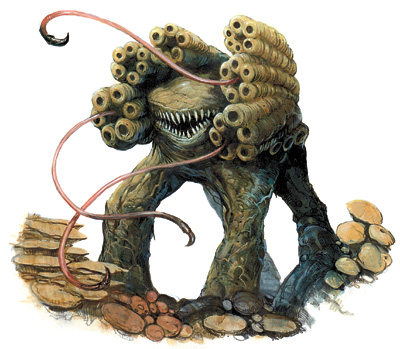
The Phantom Fungus looks very weird and kinda stupid in this illustration. Which doesn’t actually matter because it’s completely invisible almost the entire time. The stats for this monster are really very simple. It’s medium size, has animal intelligence, and is only CR 3. It’s natural invisibility is the only ability it has. Actually, you could just ignore the illustration since none of those things on its back or the tentacles coming out of them are doing anything. It is permanently invisible, walks up to you, and bites. Clearly the artist thought that this is totally boring and painted something much more interesting, if stupid looking, instead. The invisibility really is its only thing. I think the best idea is probably to just take this ability and add it to other creatures and make some really interesting monsters.
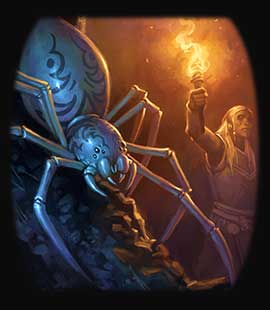
A Phase Spider is an intelligent kind of giant spider with the ability to jump between the material and ethereal planes. Since the picture in the Manual is super dull, I took this much more interesting looking one instead. Regarding their abilities, phase spiders are very simple. It’s just like a giant spider that also can use ethereal jaunt like the ethereal filcher and ethereal marauder. So it’s a teleporting spider. I loved and hated them playing Baldur’s Gate. A kind of monster I love to hate. But I think the most interesting aspect of them is that they are really very intelligent creatures and not mindless animals. They can not speak in humanoid languages, but with an Intelligence score of 7 they should be able to very effectively communicate with each other. And that makes an annoying teleporting monster in an actually very dangerous teleporting monster. These guys have no reason to just jump out and attack until they eventually run out of hit points. And just running away from their lair also doesn’t mean they forget about you. They are not smart in any way, but they are intelligent monsters, not stupid beasts. Playing them intelligent could make for really interesting adventures and more than just a single encounter. Speaking of which, I recommend reading this article by The Angry DM about encounters and combat, which among other things explains why there is no such thing as a “combat encounter”. The phase spider here is a very good example for why an encounter even with a hostile monster doesn’t start and end with initiative.
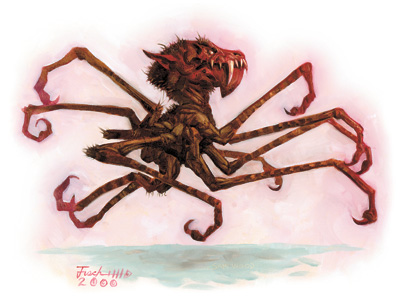
The Rast is a creature from the Elemental Plane of Fire. It certainly looks very weird. But I think the illustration doesn’t do justice to the description. “Its round head is almost all mouth, and its mouth is almost all teeth.” Rasts are very slow on the ground and actually move around by flying, with its thin legs being used mostly to attack. Rasts exist to eat. Everything and all the time. They have a paralyzing gaze that can paralyze creatures for a couple of rounds and will then concentrate its attack on those still able to fight. When they hit with a bite, they can keep the target held in place and drain 1 point of Constitution per round. Yeah, it looks freaky, but I really don’t have any idea what to do with it.
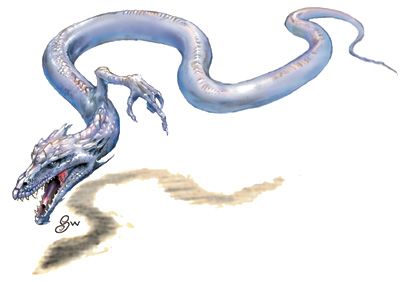
The Ravid is a creature from the Positive Energy Plane. And probably in this book to remind us that the Positive Energy Plane is a thing. It’s a flying snake of medium intelligence and neutral alignment and has a single arm. Because, why not? It can actually use the claw to make attacks, which really doesn’t seem intuitive based on the picture. Its attacks and damage are lousy, but as a positive energy creature it deals pretty good damage against undead. So maybe it’s intended as an ally? Can you summon it with a summon monster spell? It doesn’t say anything about that here though. The main special ability of the ravid is that it can use the animate object spell and uses it to make things nearby come alive and defend it. The description of the creature says that on the material plane it wanders around aimlessly followed by some animated objects. Which to me very much sounds as if the writer doesn’t have any idea what to do with this thing either.
The Shadow Mastiff is a dog with a scary face. Like most demon dogs, it makes people afraid when it howls. It can also perfectly hide in any shadows during night or underground. (Demon Dog +1)
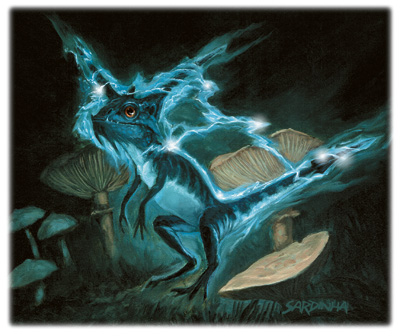
I really almost did not include the Shocker Lizard here as it’s simply a small lizard that zaps you, which seems totally mundane as monsters go. But I couldn’t stop flipping back to it because it’s so damn quirky and funny, and that really is much more important here than weird anatomy. Quirky and funny is what the Fantasy Safari is all about! So yea, it’s just a small blue lizard that for some reason got an entire full page of content. The stats are exactly what you would expect from an ordinary lizard with no surprises, except for that electricity thing. A shocker lizard can zap a creature within 5 feet to deal 2d8 points of nonlethal damage, which is pretty impressive for a creature that size. It’s a lot more than from its laughable bite, even if the target makes the fairly easy saving throw. However, when two shocker lizards are within 6 meters of each other, they can combine their power to allow one of them to create a blast of electricity that deals 4d8 points of lethal damage to everything within 6 meters around it. And you can link even more of them together for a total of 12d8 points of damage and an increasingly higher saving throw difficulty. It doesn’t really say how they create such a charge, but I would assume that it means that any shocker lizard that contributed to anothers lethal shock can not use either the stunning shock or lethal shock ability in that same round. Otherwise you would not just get 12d8 but 72d8 points of damage per round and that very clearly is not EL 7. I am not sure why, but these guys just seem really funny to me. A single one is no threat at all, even for a 2nd level party, as it can only make them unconscious and doesn’t normally eat any large creatures. In groups they become a lot more dangerous. But since they don’t usually attack unless threatened, I think these could make very interesting puzzle encounters in which the players have to find a way to get past a group without getting fried in the process. I never used shocker lizards or even saw them mentioned anywhere by either people or published adventures, but now I think they are actually one of the best low-level creatures in the book. And the picture always looked funny to me.
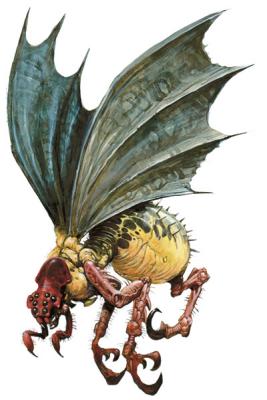
A Spider Eater is a big insect with all the abilities you’d expect from it. It flies, it stings, has poison, yadda yadda. But it’s actually worth a closer look, just as the mohrg. The poison of a spider eater deals no damage, but causes paralysis. Which lasts for 6 to 13 weeks. Which sounds cool but doesn’t actually make any sense, since the creature would die after three or four days from dehydration. Assuming the spider eater has some way to give the paralyzed creature water, it takes six weeks for its legs to hatch, after they have been implanted in the creature. Six weeks is actually quite likely for a human to survive without dying from starvation, especially when not doing any kind of activity. Unlike many other D&D monster books, the entry here doesn’t say what needs to be done to remove the eggs before they hatch. But given that it takes six weeks, this is an obvious adventure setup. Spider eaters poison people, take them to a hidden nest, and the PCs have to find it and save the people before the eggs hatch and the young spider eaters eat them. They also have the freedom of movement ability, which makes it a lot easier for them to hunt spiders, which are they most common prey. The best thing about spider eaters is that they are freaking big, and large enough to be ridden by goblins or halflings, and they can be trained as mounts.
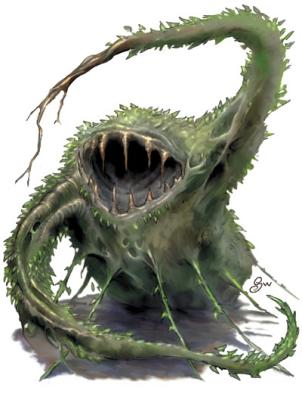
The Tendriculos is a creature I neve used or ever felt like wanting to use, but looking at it more closely I think it’s still something that might be salvagable. It’s a huge plant with a big maw and two long tentacles and weighs almost two tons. It obviously has the whole grab with tentacle and stuff into your mouth thing going on, but is even nastier in that the acid inside its stomach also causes paralysis making it a lot harder to cut your way out. Its most interesting ability is its regeneration. Only blunt weapons or acid deal any real damage to a tendriculos and it can regrow any lost body parts within a couple of minutes. It may be almost as dumb as grass, but with almost a hundred hit points, getting this thing dead should be seriously difficult. Especially when its used as the big bad boss beast of the adventure and the PCs are only 5th level.
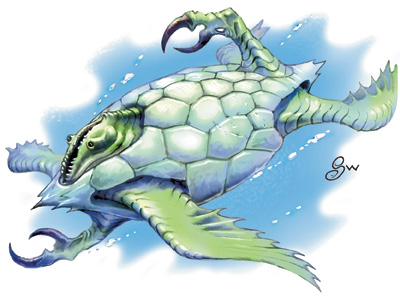
The Tojanida has a bit of a reputation as one of the really crappy monsters of the monster manual. A bit, because nobody ever uses it, but I’ve seen it mentioned quite frequently as the worst monster in the book. A tojanida is an intelligent creature from the Elemental Plane of Water that has a shell like a turtle and four fins, two claws, and one head, which it can pull inside the shell and stick out through any hole it wants, reconfiguring itselg to whatever way it needs. Which is simply weird, but not actually bad. However, like most creatures in this book, there isn’t really word on what tojanidas do, how they behave, and what they want. And cool monsters are actually never about how they look and only to a small degree about what special abilities they have, but really all about their behavior. The alien from the Alien movies is not cool or scary because it has acid blood and can impale people with its tail. It’s cool entirely because of the way it behaves. A monster book that is all about looks and special abilities, but doesn’t explain to you what a creature does is a pretty bad one. Something from which almost all WotC monster books suffer.
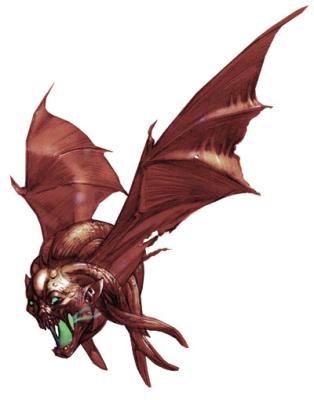
The Vargouille is a creature from before there were different creature types in D&D and eded up as an outsider in 3rd edition, even though it could just as well have been made undead like the bodak. As far as I am aware, they first appeared in the Planescape setting and they are a wonderful example of how the setting is full of things that are simultaneously silly, cool, and somewhat creepy. A vargouille is a humanoid head with a large pair of wings that has a terrifying scream that makes any creatures within 20 meters become paralyzed by fear. Their bite does very little damage, but also has a poison that makes it impossible for the target to heal any kind of injuries. But most terrifyingly, a vargouile can fly up to a paralyzed victim and give it a kiss, which starts a slow process of transformation that first makes the hair fall out, then the ears turn into large bat wings, makes it go insane, and finally causes the head to ripp off the neck and fly away as a new vargouille. Funny. But as always, some more description what you’re supposed to do with it would have been nice.
The Wight really is just a very beefed up ghoul. I like this monster and when you go into the details its background and context makes it a quite different creature. It’s still a starved corpse that sneaks around in the dark. (Variant Ghoul +1)
The Winter Wolf is a huge white wolf with who can breath icy cold and whose bite deals cold damage. Just like a color flipped hellhound. It’s bigger and tougher though, and also of human intelligence and with the ability to talk. They are not exactly masterminds, but are smart and dangerous enough to be villains in their own right who command weaker creratures as their minions. (Demon Dog +1)
And of course the Worg, because Tolkien did it. And everything that Tolkien did has to be in D&D! Its a big wolf that is slighly intelligent and evil. (Demon Dog +1)
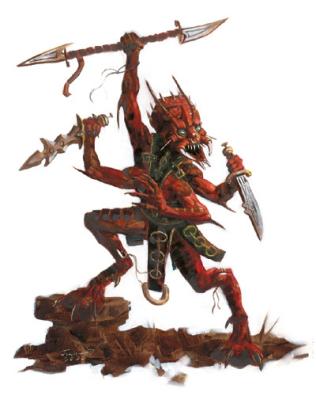
Xills are creatures that come from the novel Voyage of the Space Beagle, which also got us the displacer beast. It’s a four armed, demonic looking humanoid, but it’s actually from the ethereal plane. Unlike most ethereal monsters, it takes a xill significantly longer to move between the ethereal and material world, which makes impossible to quickly blink in and out and avoid any retaliation by its enemies. They are very intelligent and also evil, and as a nice thouch we’re also told that groups are often led into battle by a cleric of a deity of strength and travel. Their four arms help them with wrestling their enemies and when they can get a hold, they use their poisonous bite that can paralyze for several hours. The saving throw to resist it is not too high and there’s a good chance to withstand the poison, but then the xill can just try again the next round until it works. Unlike other monster (foreshadowing!) their ability to grapple is not excessively high and they can not try to bite without grappling an enemy first, which makes the ability not too powerful, but still something that can add a nice touch to a fight. Especially when the xills want to take prisoners, which they do to implant their eggs into them. With a duration of 90 days until the eggs hatch, there is plenty of time to try to rescue those prisoners and get them help. If you make some more backstory and context for them, these could be quite interesting enemies for a campaign.
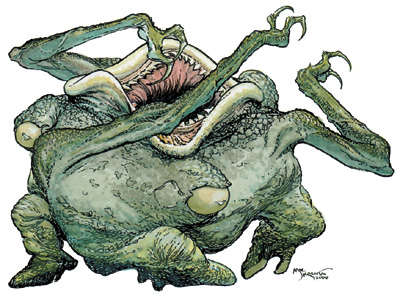
The Xorn is a very old enemy that goes back at least to AD&D 1st edition. It is also one of my least favorite ones. However, I really have to give it to the person who came up with it that it is an interesting approach to how a creature might look like that is native to a world that is almost entirely solid earth and rock in all direction to infinite, with no Up or Down dictated by gravity. It just has a front, where the huge mouth is located, and a back, where it has its feet. Like the delver, it is intelligent, has neutral alignment, and loves to eat metal. And it doesn’t have too much reservations about eating the metal that other people are carrying. Being a creature of the Elemental Plane of Earth, it doesn’t have to dig through the ground, but can just move through it as if it was immaterial. It’s actually not that bad, except that you get a bit of a problem when you have it jump at people to steal their valuables and still being neutral, but that is more a fault of alignment than the creature. If you ignore alignment (like everyone should), it’s really not bad.
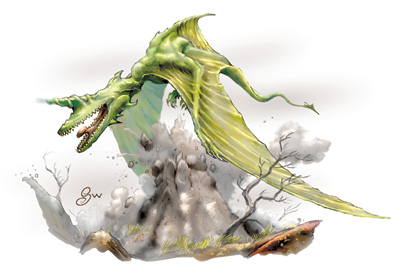
The Yrthak is one of the monster completely new to this book. It is a huge flying reptile with a wingspan of 12 meters, that may resemble a wyvern or dragon at a first glance, but has a noticable lack of any kind of eyes. Instead they sense their surroundings by echolocation by bats. While this kind of perception detects everything that is mostly solid regardless of light or the presence of illusions, this ability only has a range of 40 meters, which for a flying beast of this size really isn’t much, so it’s quite easy to just pass by without spotting the players. I would assume it can sense a general outline of the terrain beyond that distance, or it would be extremely dangerous to fly around in the mountains. In addition to its bite and claws, an yrthak can produce very powerful shockwaves from the horn on its head, which it can direct at a single nearby creature to cause considerable damage that completely ignores armor. Alternatively, it can aim the blast at stone walls, large boulders, or rocky ground to make it explode in a burst of stone shards that injure anyone within 3 meters of the impact. Even though yrthaks don’t speak, they are still quite intelligent creatures like wyverns or worgs. It seems to me that an yrthak, or multiple ones, probably work best when you prepare a special battlefield specifically for the encounter. Just in the middle of a green field wouldn’t be very interesting, you need something with lots of opportunities for the players to hide and things that the yrthak could blast to pieces. Designing such a battlefield would require some real work though, and the book doesn’t give any advice in this regard.
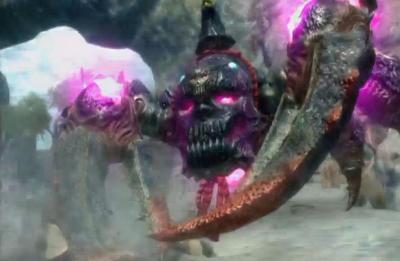
Bonus Monster: That Damn Crab! This creature is not from the Monster Manual but was released on the WotC website many years later together with two other creatures for an aquatic campaign. And it probably is the worst creature published for D&D ever! It is also a good example how the assumption that Challenge Ratings and Encounter Levels in 3rd edition are in any way objective or even reliable measures to determine how strong a creature is and what makes a good fight for a given group of characters. So this giant enemy crab is listed with a CR of 3, which really is where all of the insanity and terribleness of this monster comes from. The Monstrous Crab looks very plain and ordinary at first glance. Large Vermin with 7 hit dice and the Improved Grab and Constrict abilities, which you would expect from any 3rd edition monster with huge claws, tentacles, or even just a snake tail. It also has a Strength score of 22, which doesn’t seem too outrageous, but it becomes when you add it all together. It makes attacks with a +10 bonus to attack rolls and deals 1d8+9 points of damage. That’s quite nasty, but the giant crocodile is CR 4 and does a good deal more damage and the CR 4 polar bear has a significantly better chance to hit. So that seems pretty reasonable so far. But then we get to grappling and things get crazy. Someone thought it would be a good idea to make the Damn Crab! even better at grappling than a normal creature of its size and strength, and created the new Powerful Claws ability, which adds another +4 to grapple and increases the damage bonus from Strength 22 by another 50%. And so this thing has a grapple bonus of +19. Assuming a 3rd level fighter with 16 Strength, he would have a grapple bonus of +6. Most other 3rd level characters would be just +3 or +4. 1d20+19 versus 1d20+4 is no contest. This thing will win almost every grapple check. Unless my statistics are failing me, over 97% of the time against a character with a bonus of +4. That’s already bad. But here Constrict and Improved Grapple come into play. When the Monstrous Crab hits with an attack (with +10 the chances are good), it automatically also makes a free grapple attempt, which it will of course win. And then it also deals damage again, because of the Constrict ability. Which means if you get hit by a claw, it will crush you for massive damage of 2d8+18 (20-34) points. An unarmed 3rd level fighter might have 34 hit points. But most 3rd level characters would be happy to have even 20. If you’re not dead yet, in the next round the Damn Crab! only has to make another grapple check (which it will win) to deal another 10-17 damage and most characters will be dead by then. With an armor class of 19 and 66 hit points, you need some seriously optimized frontline PCs to take this thing out in the first round. Because if they don’t, it will just pick them up in its claw, and to do anything against a monster that grapples you, you need to win a grapple check against it. Which you won’t. It’s not that this thing is completely terribly written. It actually works, just not as a good fight against 3rd level characters. Some people who know the math of D&D better than the people who made the game have calculated that it’s strength is more comparable to monsters with a CR of 7 or 8.
Monster Manual Cliche Creature Counter:
- Evil Apes: 1
- Variant Ghouls: 1
- Demon Dogs: 5
- Skeletons with Robes: 0

http://spriggans-den.com/fantasy-safari-index/fantasy-safari-monster-manual/
old article, odd question, but I don’t suppose you remember your source for the phase spider art? I can’t find anything online and would love to include the art in a DnD homebrew PDF at a larger resolution
No clue. I think I just did an online image search for “phase spider”, or possibly even just “fantasy spider”. It was something random that came up and I have no clue where it’s originally from.